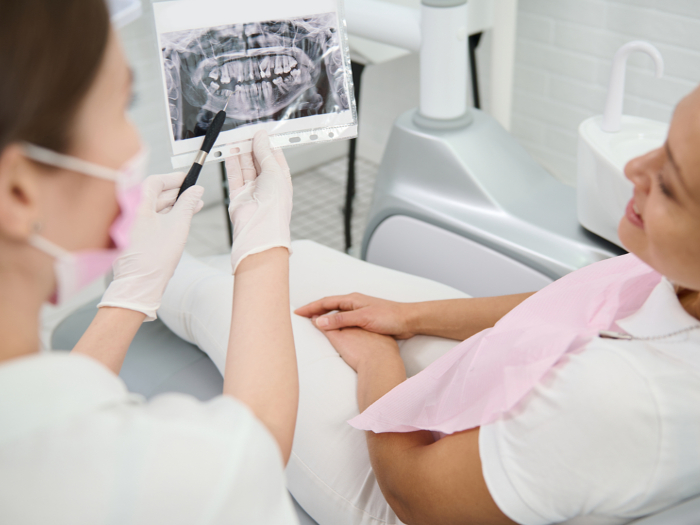In general, jawbone loss stems from tooth loss, gum disease or another medical condition affecting bone density. If the condition goes ignored, you may continue to lose teeth, experience facial atrophy or collapse, and find that various dental restoration procedures cannot be performed.
Treatment involves a bone graft, along with procedures like implants to stimulate bone growth.
How Jawbone Loss Occurs
Jawbone loss tends to be gradual, with patients often missing the early signs. However, changes can be seen on X-rays and with cone-beam imaging, allowing a dentist to recommend appropriate treatment.
Osseointegration, the fusing process that takes place while healing from dental implants, can keep your jawbone strong. Factors like the force used to chew and bite help stimulate the bone. As a result, when you lose a tooth, these signals and stimuli decline. Osteoclasts start to wear away at the jawbone and osteoblasts will not help renew its structure. In turn, your jawbone loses bone tissue at a faster rate than it’s created.
Conditions that contribute to this pattern include:
- Tooth Loss and Extractions: Teeth directly contribute to the stimulation your jawbone receives. Without them, the alveolar starts to break down, causing the jawbone to deteriorate. If the tooth is not replaced, this process continues. Aside from having a tooth extracted, trauma or the sudden loss of a tooth can contribute to this effect.
- Periodontal Disease: Periodontal disease starts with the gums but eventually affects your teeth and the jawbone beneath. Plaque is the primary source, causing bacteria colonies to form that generate acids attacking your teeth. Over time, the bacteria progresses below the gumline and can contribute to alveolar bone loss. Not only will your gums bleed, but you’ll start experiencing loose teeth.
- Sinus Issues: Pressure from the air cavity in the maxillary sinus can accelerate bone loss after a molar is extracted. This tends to affect the upper back portion of the jaw.
- Poor Alignment: Misalignment is more than a cosmetic issue – it changes bite strength and support, affecting the jawbone underneath due to a lack of stimulation.
- Health Conditions: The jawbone can experience a bacterial infection known as osteomyelitis, potentially leading to inflammation and dead bone tissue. Benign and malignant tumors may also grow on the jawbone. Both conditions require portions of the jawbone to be removed.
- Congenital Deformities: Someone may born without certain teeth or portions of jawbone. These factors can accelerate jawbone loss.
- Traditional Dentures: More dentures are now using implants to stimulate the jawbone. By contrast, patients with older dentures that sit on top of the gumline may have experienced some jawbone loss, which can affect eating and speaking.
- Additional Factors: Individuals with a history of smoking tend to be more at risk for jawbone loss.
Signs of Jawbone Loss
You may be experiencing the first signs of jawbone loss if:
- It seems like your mouth collapses into your face
- Your chin has a more pointed appearance
- You spot deeper wrinkles around your mouth
- Your dentures no longer fit comfortably
- You notice teeth shifting or moving in your mouth
- Your lips appear thinner
- You look older than your actual age
- You’re experiencing headaches without explanation
- You’re having facial and jaw pain
- You can no longer speak or eat as well
Treatment for Jawbone Loss
Before any restorative dental work is done, bone grafting will be recommended to replace lost tissue. From a human, synthetic or animal source, the new material will be absorbed by your body to generate new, natural tissue and improve the jawbone’s volume and density. After enough jawbone has been restored, you may be ready for a set of implants to replace missing teeth.
To lessen future jawbone loss:
- You may be steered toward dental implants to help stimulate the jawbone. Titanium posts act like tooth roots as you bite and chew, which helps maintain the jawbone’s strength and density.
- A socket preservation graft may be requested with an extraction to lessen bone tissue loss.
- You may be asked to change your diet to consume more calcium, Vitamin D, phosphorus and protein from natural sources and supplements.
- You’ll be asked to stop smoking and using tobacco, as both affect jawbone health.
To learn more about how our dentists can address jawbone loss, contact our Shelton office today.

